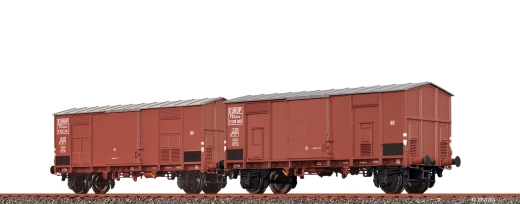Settings
Shipping country
Languages
- Products description
Products description
BRAWA 48573 - H0 pointed roof wagon F FS, unit of 2
Exemplary information
In the 1930s, road transport began to become a noticeable competitor to the transport of goods by rail. In addition, the very slow freight trains hindered efforts to increase the speed of express trains. Therefore, several European railway administrations made attempts to increase the average speed of their freight trains. This also required investments in a fleet of vehicles that could handle the higher speeds in terms of running and braking technology. The Italian State Railways (FS) then procured wagons with a riveted all-metal construction, which were notable for their wheelbase of 6.10 m and very short overhangs. The DRG took a similar path in Germany and developed the Ghs “Oppeln”, which had a wheelbase of 6.00 m. The characteristic feature of the covered Italian wagons was the pointed roof, which was used with a few exceptions. Less noticeable, but just as typical, was the use of I-profiles for the long beam. The wheel sets ran in plain bearings and, depending on the design, were supported by one, two or even three spring packs.
One of the main tasks of these vehicles was the transport of fruit and vegetables throughout Europe. Therefore, most cars had closable ventilation openings in the side and front walls near the ground. Of these, over 17,000 units with and without a brakeman's cab were put into service as Type F between 1937 and 1946. They often ran as block trains via Brenner and Gotthard to the North Sea ports. A further 4,400 cars, which differed in only one side ventilation slider, were built between 1942 and 1946. In the 1950s, a total of 3,700 cars of both F variants were added to the common EUROP car fleet. This allowed member railways to treat other people's cars as if they were their own. They had to return to their homeland just for entertainment. Until the 1980s, and thus for almost half a century, a freight train crossing the Alps without a pointed-roof wagon was almost unthinkable; even at the end of the 1990s, one was still seen in many a German marshalling yard. An identical chassis construction served as the basis for the Hg ice cream refrigerated truck. It also had the characteristic roof as well as a double-leaf loading compartment door on each side and two openings for filling with dry ice. 1,490 of the Hg were built from 1938 onwards, and after the Second World War another 1,000 were built, which had roller bearings as an innovation. The refrigerated wagons also came primarily via the Alps - long lines in the port of Hamburg are evidence of this in many contemporary photos. However, their star was already falling in the 1970s - the FS purchased UIC Standard I in large quantities.
Model details
Filigree replica of the wheel bearings
Free standing steps
True-to-original replica of the underbody
Wheels also profiled on the inside
Short coupling kinematics according to NEM
Precise printing and painting
Finely engraved rivets
Prototypical double spring packs
Technical details
Length over buffer: 210 mm
Short coupling kinematics: installed
AC wheelset replacement: possible
AC wheelset: BRAWA order no . 2187
Characteristics:
| Manufacturer: | BRAWA |
| Item number: | 48573 |
| number of pieces: | Set of 2 freight wagons |
| EAN: | 4012278485737 |
| track: | H0 |
| scale: | 1:87 |
| model series: | Freight wagon pointed roof wagon F / Hg |
| Company number: | 1139 380 / 1135 341 |
| Railway company: | FS |
| country: | I.T |
| epoch: | III |
| Wheel set replacement: | yes - possible |
| AC wheelset: | BRAWA order no. 2187 |
| Electricity system: | DC |
| operation mode: | DC analogue |
| Length over buffers: | 210mm |
| coupling: | NEM 362 shaft with KK kinematics |
| Age recommendation: | 14 years and older |
| WEEE no.: | DE14862574 |
Information according to GPSR
Manufacturer contact details
BRAWA Artur Braun Modellspielwarenfabrik GmbH & Co. KG
Uferstraße 24-30
73630 Remshalden
Deutschland
Website: www.brawa.de
E-mail addres: info@brawa.de
Telephone: +49 (0)71 51-979 35-0
Fax: +49 (0) 71 51-746 62
For further information, please visit the homepage of this product.
This Product was added to our catalogue on 02/03/2024.
Last viewed:


















